Content
In April-May, small, heavenly blue flowers appear in the gardens, which are often confused with forget-me-nots. This is Brunner Looking Glass and remains decorative all summer long. At first attention is attracted by its delicate inflorescences, and later - by the look of luxurious foliage.
Description Brunner Looking Glass
Brunner is an ornamental perennial plant. It looks like a bush with a small rhizome located vertically. From it stems up to 40 cm long depart. Heart-shaped leaves are dark green on top, on the back side - gray, slightly pubescent. Their length is about 25 cm, the tops are sharp.
Small blue flowers with a white spot in the center are collected in paniculate inflorescences. The blooming of the Looking Glass brunner lasts about a month, which can be repeated in the fall if the weather is comfortable.
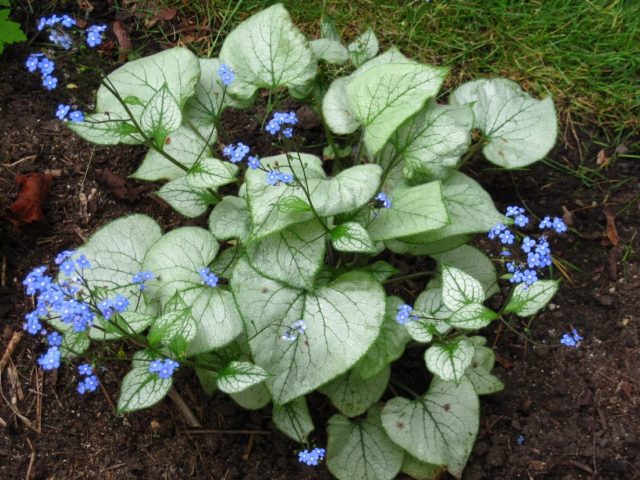
Rejuvenating transplant is recommended to be done every 3-4 years.
Growing from seeds
To grow a Looking Glass Brunner, you need to get seedlings and plant them in open ground. The difficulty lies in collecting seed. It does not ripen due to the flowering of perennials, which can last until the very frost.
One of the options for growing seedlings is sowing seeds directly into the ground in autumn and spring diving of seedlings after growing them.
Another way is to plant in boxes. For this purpose, in winter, the seed is stratified in a refrigerating chamber, in spring it is sown in containers, and after the appearance of several leaves, it is planted in the ground.
Landing in the ground
Growing brunner "Looking Glass" is a simple process that can be carried out not only by sowing seeds and growing seedlings, but also by dividing the mother bushes and rhizomes. This method allows you to preserve all the varietal qualities of the plant, including variegation, to observe flowering already in the current season. With the seed method of reproduction, the first flowering is later - 2-3 years after planting.
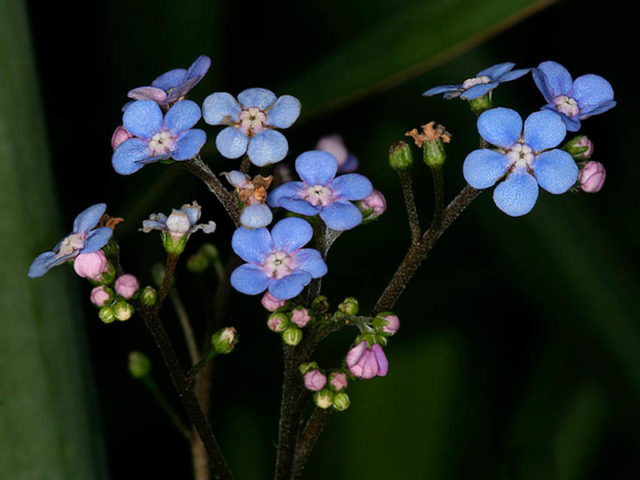
The people often call the plant a forget-me-not.
Site selection and preparation
For the Looking Glass Brunner, the ideal area is the area illuminated by the sun in the morning and shaded during the rest of the day. If there is a constant shadow in the place chosen for the plant, the shoots are stretched out, flowering is poor. A sunny place is not suitable due to the possibility of drying out the soil and lack of moisture.
Loam is an ideal soil for growth. The perennial does not need watering or feeding. On poor soil, it is not recommended to apply fresh manure, so as not to skew towards excessive growth of leaf mass and poor wintering.
To prepare the soil for planting, it is carefully dug up, weeds are removed, well-rotted compost is introduced.
Planting stages
You can plant the Looking Glass brunner throughout the season until September. The optimal period is July-August. Planting is carried out on a cool, cloudy day. The algorithm should be followed:
- Cut off the foliage, leaving 10-12 cm of stalks.
- Dig up the root of the mother plant, immerse it in warm water.
- Remove damage and rot from the roots.
- Divide the rhizome into several parts using a sharp, sanitized knife.
- Dig holes according to the size of the root system.
- Place "delenki" in them.
- Sprinkle with soil, tamp a little.
- Water and mulch.

The aerial part of the brunner "Looking Glass" is used in folk medicine as an anti-inflammatory and antipyretic agent.
Care
A perennial is an unpretentious plant that, with the right choice of place, can grow on it without problems for up to 15 years. Brunner Looking Glass needs to constantly keep the soil moist. Under this condition, it looks great, blooms beautifully and develops. It is worth mulching the soil in order to avoid moisture loss and maintain its air permeability, loose state.
Weeds are removed periodically. Experts advise cutting off the flower stalks that have finished flowering in order to avoid self-seeding. On poor soils, fertilizing is carried out twice a season, using organic and mineral fertilizers.
Diseases and pests
Abundant, prolonged precipitation, creating high humidity, can provoke the development of brown spot on the Brunner. The fungal disease affects the leaves, on which olive and then brown spots appear first. On the back side, spores accumulate, quickly spreading throughout the plant. The leaves dry, the perennial weakens, develops poorly and blooms. To combat pathology, the affected leaves should be removed, and the rest should be treated with fungicides.
The main pests for the Looking Glass brunner are aphids and whiteflies, which damage plants by feeding on their sap and leaving sticky waste products on the leaf plates. To get rid of them, use a contact insecticide ("Actellikt").
Snails and slugs that attack plants are harvested by hand, trapped or treated with pesticides.
Pruning
To maintain a healthy appearance, the plant needs pruning, which is carried out in three stages according to the following scheme:
- After flowering (in June), the peduncles are removed so that the plant does not waste energy on ripening the seeds.
- The second pruning is done in August. The emerging peduncles are cut off, preventing the weakening of the plant by winter.
- After the first frost, the entire aerial part is removed to prevent the spread of pests and diseases.
Preparing for winter
Brunner's Looking Glass is winter-hardy and does not require additional shelter for the winter. As a preparation for the cold weather, the plant is cut off and the soil is mulched with compost, humus or peat. This event is especially important before the harsh and little snowy winters. With the onset of spring, the mulch is removed, the earth is loosened.
Reproduction
For reproduction brunners "Looking Glass" use two methods - seed and vegetative.
The first method is less preferable because the process is time-consuming and varietal characteristics may not be preserved.
The vegetative method (by dividing the rhizome) is simple and effective. Among the advantages of the method is the rapid restoration of the aboveground part, obtaining a large number of new plants from one mother plant.
Photo in landscape design
Brunner's Looking Glass is often used by gardeners and designers to decorate the landscape in shady areas of the garden.
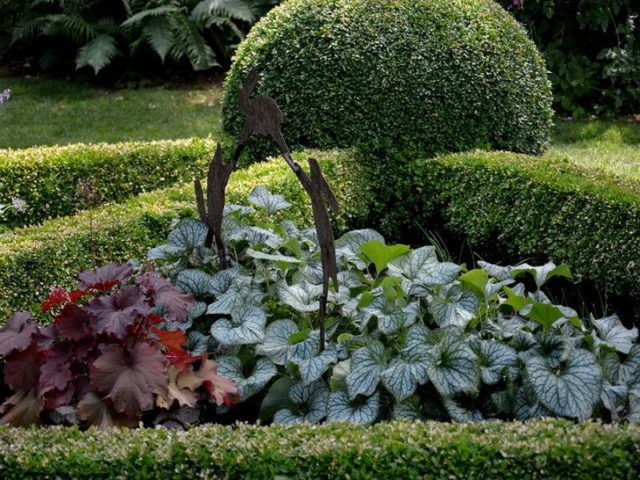
As "partners" for brunners "Looking Glass" use plants of different texture, color and shape

Grows well on the north side of the house where rainwater flows from the roof Grows well on the north side of the house where rainwater flows from the roof
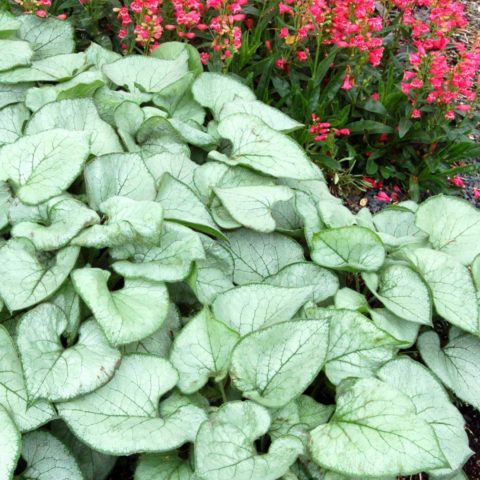
Thanks to its brunner appearance, Looking Glass looks equally impressive in rocky gardens, on alpine slides and in mixborders.
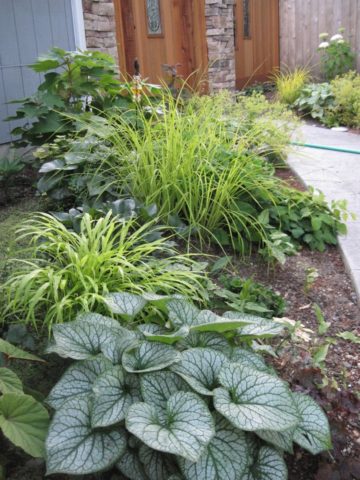
Brunner can grow in one place for many years
Conclusion
To decorate the shady garden of Brunner, the Looking Glass is indispensable. Its bright foliage and delicate flowers get along well with trees and shrubs.An additional bonus for gardeners is unpretentiousness and minimal plant care.








